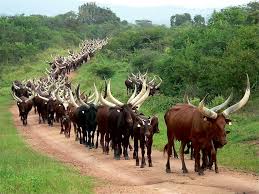Sons of Ruhanga in Ankole Kingdom

Do you know the sons of Ruhanga in Ankole? Read the scrip below:
Abagahe clan is a sub- division of Abahinda clan, “the ruling clan,” who originated from Karagwe/ Tanzania around 1447, they entered Mpororo in Ntungamo District, while others dispersed to different parts of Uganda like Bushenyi District, Lyantonde District, Ibanda District, Kiruhuura District, Kazo District, Rukungiri District, Buhweju District, Kamwengye District and other districts of the western and eastern Uganda.
Abagahe in Ankore Kingdom was a trusted clan to Omugabe, they were worriers and herdsmen to the King (Omugabe). Omugabe would marry from the Abagahe and Abasambo clans.
Clans
1. Abagahe 2. Abayombo 3. Abasiingo 4. Abasiita 5. Abatoroogo 6. Abariisa 7. Abataizi 8. Abakuruungu 9. Abayangwe 10. Abanyakafunjo 11. Abahwiba 12. Abatende 13. Abataayi 14. Abashengyeera 15. Abanyaigana 16. Abanyaihimbi 17. Abagina 18. Abahome 19. Abazigaaba 20. Abamoori 21.Ababiito 22. Abasheegi 23. Abaha 24. Abakibiza 25. Abayebe 26. Ababuga 27. Abaziro 28. Abanuuma 29. Abashaju 30. Abanyaara 31. Abaranzi 32. Abarengye 33. Abaganga 34. Abaturumba 35. Abene nyarubamba 36. Abene kihimba 37. Abene nyakihunga 38. Abene itaka 39. Abene kyeitamba 40.Abene biraaro 41. Abene matsya 42. Abayanzi 43. Abaruru.
NB: Not only Abagahe are found in Bahima, in Ankole Kingdom but also in other tribes like Banyarwanda, Batooro, Bahororo, Banyoro, Bakiga Bamba etc….
The Son’s of Ruhanga before Banyankore migrated from their ancestral land Karagwe around 1447 were Kakama, Kahima and Keiru and you know how they passed an exam that was given by their Father (Ruhanga).
Kakama held his ekyanzi ( milk goard ) filled with milk without sleeping till morning as he passed his exam being under the ruling clan.
Kahima held his (ekyanzi) when he slept some of the milk spilled down and he left with half way, from there clans’ herdsmen and worriers came about, for it was a tag of war for Kahima to remain with half way milk in his (ekyanzi) being disturbed by slumber.
Then Keiru forgot and slept till morning, his whole milk in his (ekyanzi) was spilled on the floor and ekyanzi was broken, there the clans of abeiru came about; these are agriculturalists, albeit they were identified under the clans of Abagahe and Abasambo by their activities which were not connected to the cows or cattle’s.
The Bahinda (ruling clan) and Bahima (Abagahe and Abasambo) were intertwined/ inseparable since Omugabe would marry from them or get his Queen from them and you well know that Omugabe would not marry one wife, but he would marry a girl/ girls whose family/ families was/were identified with activities connected to the cows or cattle.
For marrying a girl/ girls being not identified with activities connected to the cows or cattle was looked at as a bad omen or bad luck, but he would not do such.
Kakama ( father of the ruling clan) was identified under Bahinda clan like as you have noted before the Bahinda clan would marry either from Bagahe clan (who were identified by activities of taking care of their cattle or cows and defending Omugabe at the same time due to being worriers).
The intermarriages between Kakama ( father of the ruling clan- Bahinda), Kahima (herdsmen and worriers- Bagahe & Basambo clans) would lead to the birth of Princess and Princesses, then Keiru (Beiru- agriculturalists), these were clans which had activities that were not connected to the rearing of cattle or cows.
In that case, the Bahima were the ones who knew how to take care of cows; this is how the name Bahima came about in Ankole Kingdom.
Since Bahinda under Kakama would marry from Bagahe and Basambo clans, it means that all clans under Bagahe and Basambo clans excluding (Beiru agriculturalists); Omugabe would get his wife/ wives from their line and produce his children (Princess and Princesses).
This meant that a king would come from either of the clans excluding the clans of Beiru (agriculturalists) who had activities not connected to the cows or cattle.
Kakama (Bahinda) & Kahima (Bagahe & Basambo clans) were united to be under Bahinda clan, then other sub -clans followed it, and Beiru excluded for having no activities not connected to the cows.
The Bahima were the ones who would keep cattle even today; for they were identified by clan and cattle keeping activities; those were Bagahe and Basambo, albeit different activities made them either Bahima (cattle keepers) or Beiru (agriculturalists).
The Bahima without cattle were called “Barisa” or “Abarisa” but would remain identified as Bahima basing on their clan and activities they were accustomed to in that case, irrespective of the different places they lived, the slip of the tongue, riddles (ebitebyo) and the nose.
In a nutshell, even if Beiru- would keep cattle/ cows, they would not be called Bahima. According to the Chief Priest Kakara Kashagama who they got on special arrangement from Karagwe by Kyomya and Katariiga (a Muganda) who used to light fires of Wamala (Kuragura Engoma ya Nkore/ Ankole Kingdom) meaning prophesying about the kingdom . He said that (Engoma Bagyendanwa) was not only for Bahinda.
Clans in Ankore Kingdom would help each other as far as community participation and community development was concerned, hence development of Ankore Kingdom up to today, though the kingdom is inactive.

